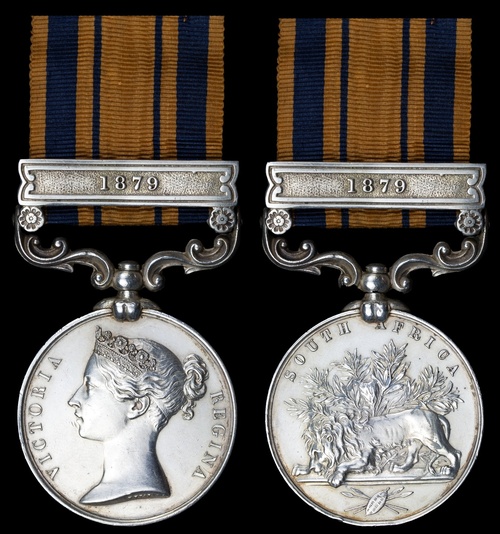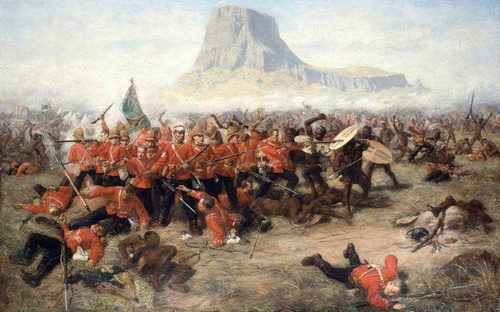Auction: 25001 - Orders, Decorations and Medals
Lot: 163
The 24th (2nd Warwickshire) Regiment of Foot
The exploits of both Battalions of the 24th Foot during the Zulu War need little introduction. They are perhaps the most storied of all regiments to set foot in South Africa during 1877-79. Scores of worthy titles are recommended, with The Washing of the Spears perhaps a good place to start for one with a new-found enthusiasm.
The Zulu War Medal awarded to Private J. M. Meredith, 1st Battalion, 24th (2nd Warwickshire) Regiment of Foot, who was killed in action at the disastrous Battle of Isandlwana on 22 January 1879
South Africa 1877-79, 1 clasp, 1879 (293. Pte. J. Meredith. 1-24th. Foot.), rod perhaps tightened at some point, very fine
John Henry Meredith was born at Rhosyoside, Ruabon, Denbighshire on 27 December 1854, son of Henry and Ann, his father being the local tailor. Young Meredith enlisted at Manchester, Lancashire on 17 June 1874, aged 19 years. He served with 'H' Company and was killed in action at Isandhlwana on 22 January 1879, with his effects, to include the Medal & clasp '1879' were claimed by his father.
Both Battalions of the 24th participated in the campaign (each fielding six companies) with the 1st Battalion forming the principal element of Number Three Column, which was under the overall command of Colonel Richard Glyn of the 1st/24th: therefore Brevet Lieutenant-Colonel Henry Pulleine was appointed to command in his stead.
Upon crossing the Buffalo River on 11 January, the column (accompanied by the Commander-in-Chief, General the Lord Chelmsford) found itself pitching camp nine days' later at the base of a prominent feature - the hill at Isandlwana. Chelmsford, eager to bring the campaign to a swift conclusion, departed at dawn on 22 January with half the column's strength (some 2,800 men) leaving behind Pulleine with approximately 1,300 men - five companies of the 1st/24th, one company of the 2nd/24th, 700 men of the Natal Native Contingent, two 7-pdr artillery pieces and a rocket battery.
Failing to take any defensive measures to secure the camp, Pulleine's force was subsequently surprised by a vast Zulu army totalling some 20,000 warriors which, by additionally using the terrain to their advantage, swept forward to the attack using their traditional 'Horns of the Buffalo' strategy - a central advance supported by encircling forces on both flanks. Pulleine deployed the 24th Foot some way in advance of the camp in an extended firing line, aiming to subdue the Zulus with superior firepower - the young Meredith must have been one of those men in the line; what he likely thought and felt at that moment defies description.
For at least an hour, the British held the Zulu warriors at bay, inflicting significant casualties with their powerful Martini-Henry rifles and aided by support from the two 7-pdr guns from N/5 Battery Royal Artillery. However, as the mounted force (commanded by Colonel Anthony Durnford) began to withdraw in the face of mounting numbers of Zulus, this exposed the right flank of the British infantry firing-line; G Company (2nd/24th) was swiftly overrun and the remainder also began a withdrawal, loading and firing as they went, back towards the camp. However, by this point the Zulu encirclement of the position had almost been completed and the remains of the British force were left with no option but to either try to fight their way out or fight to the death - the result has subsequently been recorded as one of the most famous 'Last Stands' in British military history, immortalised in paintings, books, and the 1979 major motion picture 'Zulu Dawn' starring Peter O'Toole and Denholm Elliot amongst many other household names.
Of the 1,800 men at Isandlwana over 1,300 of them were killed; the bodies of the slain were afterward buried in mass graves on the battlefield, their last resting places still marked to this day by white-painted stone cairns; Private Meredith is amongst them.
In July 2001, DNW sold another Medal (bearing both initials but the incorrect '1878-8-9' clasp) to this man. This Medal was inspected by John Hayward in April 2006 and the assumption that a duplicate must have been made at some time. This Medal was considered entirely as issued.
Subject to 20% VAT on Buyer’s Premium. For more information please view Terms and Conditions for Buyers.
Estimate
£3,000 to £5,000
Starting price
£2400







